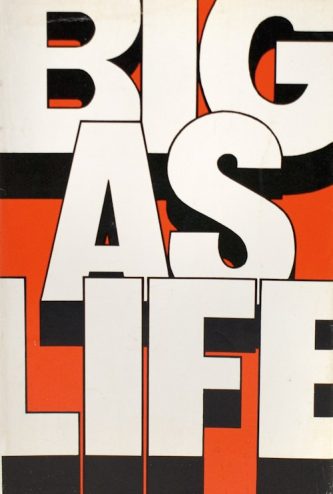 By E.L. DOCTOROW (Simon and Schuster; 1966)
By E.L. DOCTOROW (Simon and Schuster; 1966)
A definite oddity in the cannon of the late E.L. Doctorow, who specialized in historical fiction. In BIG AS LIFE, his second novel, Doctorow tried his hand at surreal fantasy, relating the highly speculative account of two giant humanoid figures who one day appear suspended in the sky over the New York Harbor, throwing the city into chaos.
How well Doctorow fared in such unfamiliar fictional territory is evidenced in the fact that he never allowed BIG AS LIFE to be reprinted after its initial 1966 publication. It is frankly a bit of a hodge-podge, encompassing science fiction, social commentary and satire, with a tone and focal point that tend to shift from chapter to chapter. It seems Doctorow may have been attempting the kind of kaleidoscopic narrative swirl that characterized later novels like RAGTIME, but wasn’t yet up to the task of pulling it off.
But anyway: the giant critters, we learn, are beings from some other dimension where time flows at a crawl, so they appear to move in extreme slow motion. Early on in the story a plane crashes into the head of one of the giants, causing one of its hands to slowly move upward to the spot of the collision and an endlessly drawn-out wail to emit from its mouth. In the meantime people are dispatched to climb onto and study the giants’ anatomies first-hand.
Intriguing stuff, but Doctorow doesn’t go very far with the speculative business. His concern is with the civilians attempting to maintain a sense of normality amid the mass rioting and martial law that engulf the city, particularly the free-spirited jazz musician Red, his pregnant girlfriend Sugarbush, and Creighton, a history professor who shacks up with Red and Sugarbush. Layered in are passages, such as one describing Red sprayed with a fire-hose by authorities, that were evidently meant to recall past upheavals, and others, such as the creation of a government agency called the New York Command, Research and Defense—or NYCRAD—that would appear to foreshadow future catastrophes (specifically 9/11). The resolution, in any event, is inconclusive and unsatisfying.
One can only imagine what a more fantastically-inclined writer like J.G. Ballard (whose story “The Drowned Giant” has many similarities with BIG AS LIFE) might have done with this material. As it is, however, it stands as a somewhat interesting but deeply flawed and, as its own author evidently agreed, best forgotten novel.
